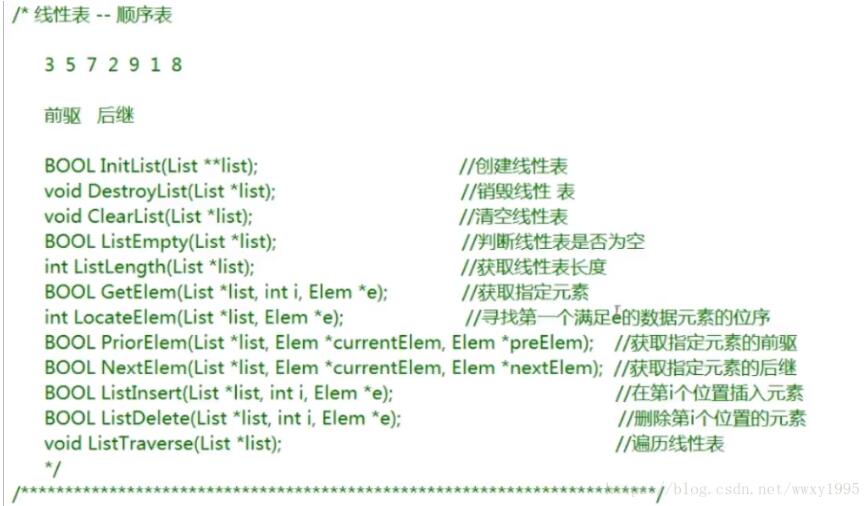C++通过类实现线性表
wwxy261 人气:0本文实例为大家分享了C++类实现线性表的具体代码,供大家参考,具体内容如下
下图是标准C语言实现的函数定义

下面可以用C++实现,第一个参数就是this的指针
list.h函数
#pragma once
typedef int Elem;
class List
{
public:
List(int size);
~List();
void ClearList(); // 将数组长度设为0
bool ListEmpty(); // 判断数组是否为空
int ListLength(); // 获取数组长度
bool GetElem(int i, Elem *e); // 查找指定下标元素
int LocateElem(Elem *e); // 查找指定元素
bool PriorElem(Elem *currentElem, Elem *preElem); // 查找元素的前驱元素
bool NextElem(Elem *currentElem, Elem *nextElem); // 查找元素的后继元素
void ListTraverse(); // 遍历线性表,输出元素
bool ListInsert(int i, Elem *e); // 在指定位置插入一个元素
bool ListDelete(int i, Elem *e); // 删除指定位置元素
private:
int *m_pList; // 指向一块内存
int m_iSize; // 内存的大小
int m_iLength; // 数组的长度
};
类的实现,list.cpp
#include<iostream>
#include "List.h"
using namespace std;
List::List(int size)
{
m_iSize = size;
m_pList = new Elem[m_iSize];
m_iLength = 0;
}
List::~List()
{
delete[] m_pList; // 释放数组内存
m_pList = NULL;
}
void List::ClearList()
{
m_iLength = 0;
}
bool List::ListEmpty()
{
return m_iLength == 0 ? true : false;
}
int List::ListLength()
{
return m_iLength;
}
bool List::GetElem(int i, Elem *e)
{
if (i < 0 || i >= m_iSize)
{
return false;
}
*e = m_pList[i];
return true;
}
int List::LocateElem(Elem *e)
{
for (int i = 0; i < m_iLength; i++)
{
if (m_pList[i] == *e)
{
return i;
}
}
return -1;
}
bool List::PriorElem(Elem *currentElem, Elem *preElem)
{
int temp = LocateElem(currentElem); // 查找元素的序号
if (temp == -1)
return false;
else if (temp == 0)
return false;
else
{
*preElem = m_pList[temp - 1];
return true;
}
}
bool List::NextElem(Elem *currentElem, Elem *nextElem)
{
int temp = LocateElem(currentElem); // 查找元素的序号
if (temp == -1)
return false;
else if (temp == m_iLength - 1)
return false;
else
{
*nextElem = m_pList[temp + 1];
return true;
}
}
void List::ListTraverse()
{
for (int i = 0; i < m_iLength; i++)
{
cout << m_pList[i] << endl;
}
}
bool List::ListInsert(int i, Elem *e)
{
if (i<0 || i>m_iLength)
return false;
for (int k=m_iLength-1;k>=i;k--)
{
m_pList[k + 1] = m_pList[k];
}
m_pList[i] = *e;
m_iLength++;
return true;
}
bool List::ListDelete(int i, Elem *e)
{
if (i<0 || i>m_iLength)
return false;
*e = m_pList[i];
for (int k = i + 1; k < m_iLength; k++)
{
m_pList[k - 1] = m_pList[k];
}
m_iLength--;
return true;
}
测试主程序
#include<iostream>
#include "List.h"
using namespace std;
int main()
{
Elem temp;
Elem arry[11] = { 3,5,7,2,9,1,8 };
List *list1 = new List(10);
cout << "length:" << list1->ListLength() << endl;
for (int i = 0; i < 7; i++)
{
list1->ListInsert(i, &arry[i]);
}
cout << "length:" << list1->ListLength() << endl;
// 删除第一个元素
list1->ListDelete(0, &temp);
cout << temp << endl;
// 搜索前驱元素
list1->PriorElem(&arry[4], &temp);
cout << temp << endl;
list1->NextElem(&arry[4], &temp);
cout << temp << endl;
list1->ListTraverse();
delete list1;
return 0;
}
加载全部内容